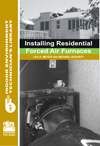ATLANTA — With recent research showing that ultrafine particles are more hazardous to human health than originally thought, higher-efficiency filters should be used, according to the newly published 2015 version of ASHRAE’s residential IAQ guideline.
Guideline 24-2015, Ventilation and Indoor Air Quality in Low-Rise Residential Buildings, provides information on achieving good IAQ that goes beyond the requirements contained in Standard 62.2, Ventilation and Acceptable Indoor Air Quality in Low-Rise Residential Buildings, by providing explanatory and educational material not included in the code-intended standard. Guideline 24 is the companion document to Standard 62.2.
“In the 2008 version, we indicated that if a lot of ultrafine particles were expected, higher-efficiency filters should be considered. Period,” said Paul Francisco, chair of the Guideline 62.2 committee. “Now we say a lot more. We cite research that shows that ultrafine particles are a much more significant concern, and we state explicitly that higher-efficiency filters mean MERV 13 or higher.”
Rick Karg, a member of the Guideline 24 committee who oversaw the revision of the section, notes that particle filters with minimum efficiency reporting value (MERV) ratings below 6 are poor at filtering out respirable particulates (typically below 2.5 microns), but can do an acceptable job at removing the large visible particles such as fibers, insects, or large dusts or pollens. ANSI/ASHRAE Standard 52.2, Method of Testing General Ventilation Air-Cleaning Devices for Removal Efficiency by Particle Size, specifies removal efficiency values for particulate filters.
“Recent research suggests that mass of particles below 2.5 microns (PM2.5) may be one of the most significant indoor airborne contaminants in terms of chronic health impact in residences of those that have been well studied,” Karg said. “PM2.5 is also the most straightforward contaminant to remove from indoor environments through filtration. MERV 10 rated filters and higher are preferred for removing smaller airborne allergens and PM2.5 particles.”
As such, Guideline 24 recommends that higher-efficiency (MERV 13 and higher) filters should be considered. Multistage particle filtration (a relatively coarse filter followed by a high-efficiency filter) can help filter out different sized particles without overloading the higher-efficiency filters. When selecting filters, consideration should be given to the effects of the filter’s pressure drop on delivered airflow, fan capacity, and energy use, according to Karg.
Other significant changes to Guideline 24 are:
• Important new definitions, which align the guideline with Standard 62.2.
• Section 4.3.7 Estimating Health Impacts of Contaminant Exposure. Discusses the new methods for quantifying the impact of contaminant exposure, including Disability Adjusted Life Years (DALY).
• Section 5.4.5 Interplay of Mechanical Ventilation and Infiltration. Addresses the important differences between the manner in which balanced and unbalanced mechanical ventilation impact infiltration (natural air leakage). This difference can significantly impact the total ventilation available (mechanical plus infiltration) in a dwelling.
In addition, several other updates were made. Among these are:
• Tables 4.1, Comparison of Regulations and Guidelines Pertinent to Indoor Environments, and Concentration of Interest for Selected Contaminates. Both of these tables were vetted by a number of experts to bring the data up to date.
• Significant updates and expansion to Sections 7 Moisture; 8.6, Combustion Appliances; 12, Verification of Equipment Performance; and 13, Ventilation Controls.
• Section 10 Mechanical Ventilation Systems Design includes significant updates and expansion. A new subsection now includes range hoods and the related discussion of the new metric, capture efficiency.
• References. Approximately 20 references were added and all previous ones were vetted for needed updates.
The cost of Guideline 24-2015, Ventilation and Indoor Air Quality in Low-Rise Residential Buildings, is $58 ($48, ASHRAE members). To order, visit www.ashrae.org/bookstore or contact ASHRAE Customer Contact Center at 800-527-4723 (United States and Canada) or 404-636-8400 (worldwide) or fax 678-539-2129.
Publication date: 9/16/2015
Want more HVAC industry news and information? Join The NEWS on Facebook, Twitter, and LinkedIn today!








